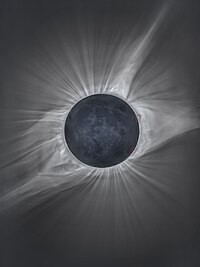
Photo from wikipedia
Diamond samples of defects with negatively charged nitrogen-vacancy (NV) centers are promising solid-state spin sensors suitable for quantum information processing and highly sensitive measurements of magnetic, electric, and thermal fields… Click to show full abstract
Diamond samples of defects with negatively charged nitrogen-vacancy (NV) centers are promising solid-state spin sensors suitable for quantum information processing and highly sensitive measurements of magnetic, electric, and thermal fields at the nanoscale. A diamond defect with an NV center is unique for its robust temperature-dependent zero-field splitting Dgs of the triplet ground state. This property enables the optical readout of electron spin states through manipulation of the ground triplet state using microwave resonance with Dgs from 100 K to approximately 600 K. Thus, prohibiting Dgs from external thermal disturbances is crucial for an accurate measurement using NV-diamond sensors. Nevertheless, the external microwave field probably exerts a heating effect on the diamond sample of NV centers. To our knowledge, the microwave heating effect on the diamond samples of NV centers has yet to be quantitatively and systematically addressed. Our observation demonstrates the existence of a prominent microwave heating effect on the diamond samples of NV centers with the microwave irradiation in a continuous mode and some pulse sequence modes. The zero-field splitting Dgs is largely red-shifted by the temperature rises of the diamond samples. The effect will inevitably cause NV-diamond sensors to misread the true temperature of the target and disturb magnetic field detection by perturbing the spin precession of NV centers. Our observation demonstrates that such a phenomenon is negligible for the quantum lock-in XY8-N method.
Journal Title: ACS Omega
Year Published: 2022
Link to full text (if available)
Share on Social Media: Sign Up to like & get
recommendations!